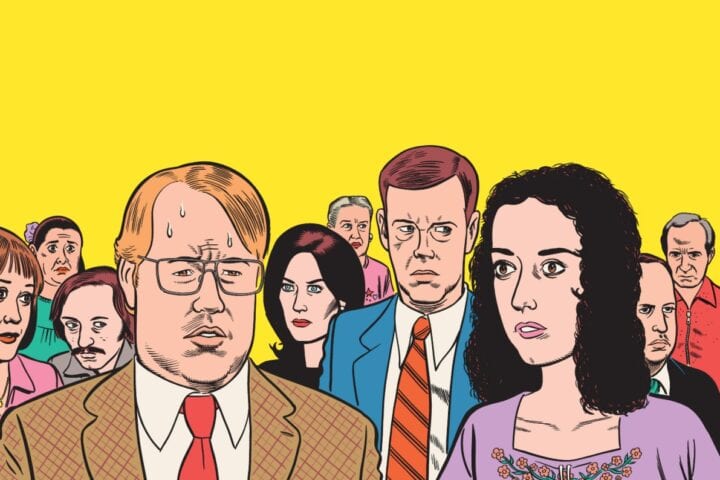Like most of the cinema’s recurring images and sensations, there’s no precise “first movie” about the maladjusted, dissatisfied, wounded soul (usually a man, a brooding lion with a thorn in his paw), but the floodgates about this most serious of fellows seemed to open just after World War II. The late 1940s and early ’50s witnessed the infiltration of the New York theater, Marlon Brando, Elia Kazan, Stanley Kramer, Robert Rossen, Abraham Polonsky, Nicholas Ray, and so on—directors, scribes, or actors whose meal tickets more often than not depended on their ability to write the counter-mythology to V-Day utopia. They asked, amid the fanfare and the ticker-tape parades, “Is this all there is?”
Deities such as Brando and James Dean were responsible for taking that particular ship into orbit, but John Garfield was a pioneer of sorts, as early as 1938’s Four Daughters, where his appearance in such a genteel trifle was no less jarring than a Martian invasion. That massive chip on that massive shoulder resurfaced several times afterward, most memorably in Howard Hawks’s Air Force, the original version of The Postman Always Rings Twice, and Jean Negulesco’s Humoresque. But it was his performance in Rossen’s Body and Soul, as the soul-burdened prizefighter Charley Davis, that ensured his immortality.
The film uses some of the same origin-story material as Humoresque. Charley Davis is a New York City kid, like Garfield himself, and, like his character in the Joan Crawford weepie, he’s got a terrific talent for doing things with his hands—only it’s knocking men out, not playing the violin. Using a flashback structure that no longer, by 1947, bewildered movie audiences, Body and Soul relates a rather rote (also by 1947) melodrama about a fighter who must choose between his values and his bankroll. Or, perhaps more lyrically, his mama or the mob.
Rossen’s direction of Polonsky’s screenplay is resolutely televisual, in the sense that scenes are performed and shot in the manner of a live broadcast, the cutting by Robert Parrish a rudimentary tango between cameras A and B. Rossen rarely knows what to do when more than one actor is in the frame; with three or more, his compositional sense starts to disintegrate in apparent panic. But various departments acquit themselves honorably. Legendary cinematographer James Wong Howe donned roller skates to shoot the spectacular fight scenes, and it’s widely acknowledged that, had he not done so, we’d have no Raging Bull.
The film’s most potent legacy, though, is the unfathomable—and extra-cinematic—sadness that surrounds it. While the cast and crew roster boasts no fewer than six names of men who’d go on to become either great or dependable directors on their own, the HUAC witch hunt took its toll on many of them. It can be argued that the blacklist was lethal for Garfield and co-star Canada Lee, both of whom succumbed to heart attacks in May of 1952, less than two weeks from one another. Body and Soul may have begun life as a prestige melodrama that aspired to be acclaimed for its depiction of the moral battles grown men must fight during peacetime, but it’s hard to see today without the dark cloud of real events that followed in its wake.
Image/Sound
Kino’s HD transfer of a new 4K restoration is a bona fide knockout. Image detail is immaculate, as evinced by the textures of all the fine suits and mink coats, as well as the sweat, cuts, and bruises on the boxers in the ring. Contrast is also very strong, and the velvety blacks and wide range of grays allow for a fuller appreciation of cinematographer James Wong Howe’s spectacular images. Through it all, the even grain distribution helps retain a filmlike look. The audio presentation is equally impressive, boasting a nice depth that adds resonance to the increasingly brutal fights, while the music and dialogue are cleanly placed in the mix.
Extras
Alan K. Rode’s audio commentary is the real deal, as the author and film historian touches on virtually every aspect of Body and Soul, including the controversy that would soon surround numerous people involved in its making. Rode discusses Howe’s groundbreaking cinematography, including his filming of some of the boxing scenes with a handheld camera while on roller skates, as well as the film’s anti-capitalist themes. In a particularly interesting stretch, Rode covers the history of Enterprise Pictures, whose meteoric rise to popularity, at least among actors, and rapid downfall mirrors the tragic trajectory of one of its founders, John Garfield. The main event is, of course, the HUAC hearings, during which Robert Rossen named names and Garfield and Abraham Polonsky landed on the blacklist.
Overall
Body and Soul is deserving of a meatier release, but the comprehensive audio commentary and top-notch A/V presentation are enough to make Kino’s Blu-ray a real contender.
Since 2001, we've brought you uncompromising, candid takes on the world of film, music, television, video games, theater, and more. Independently owned and operated publications like Slant have been hit hard in recent years, but we’re committed to keeping our content free and accessible—meaning no paywalls or fees.
If you like what we do, please consider subscribing to our Patreon or making a donation.

